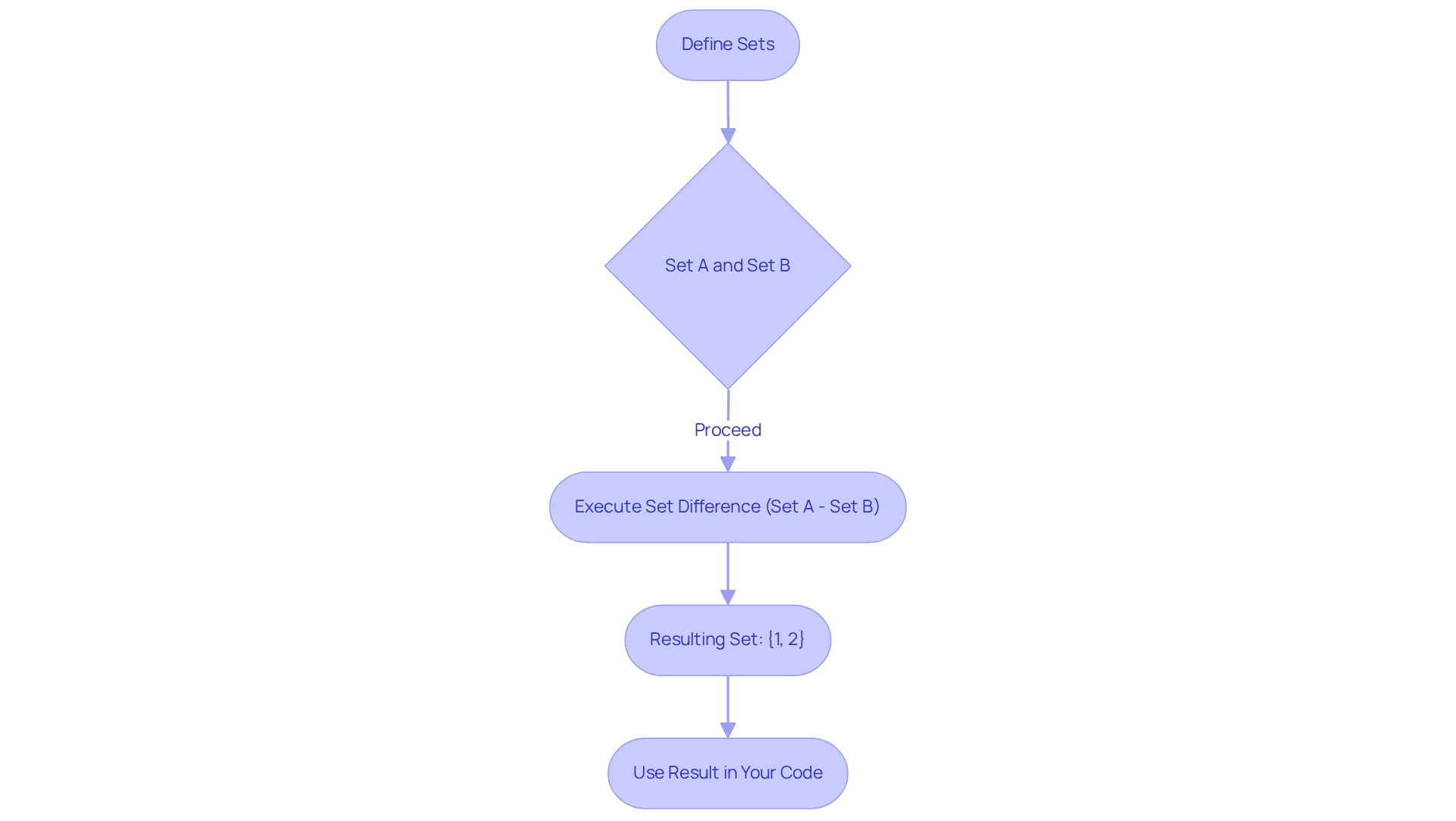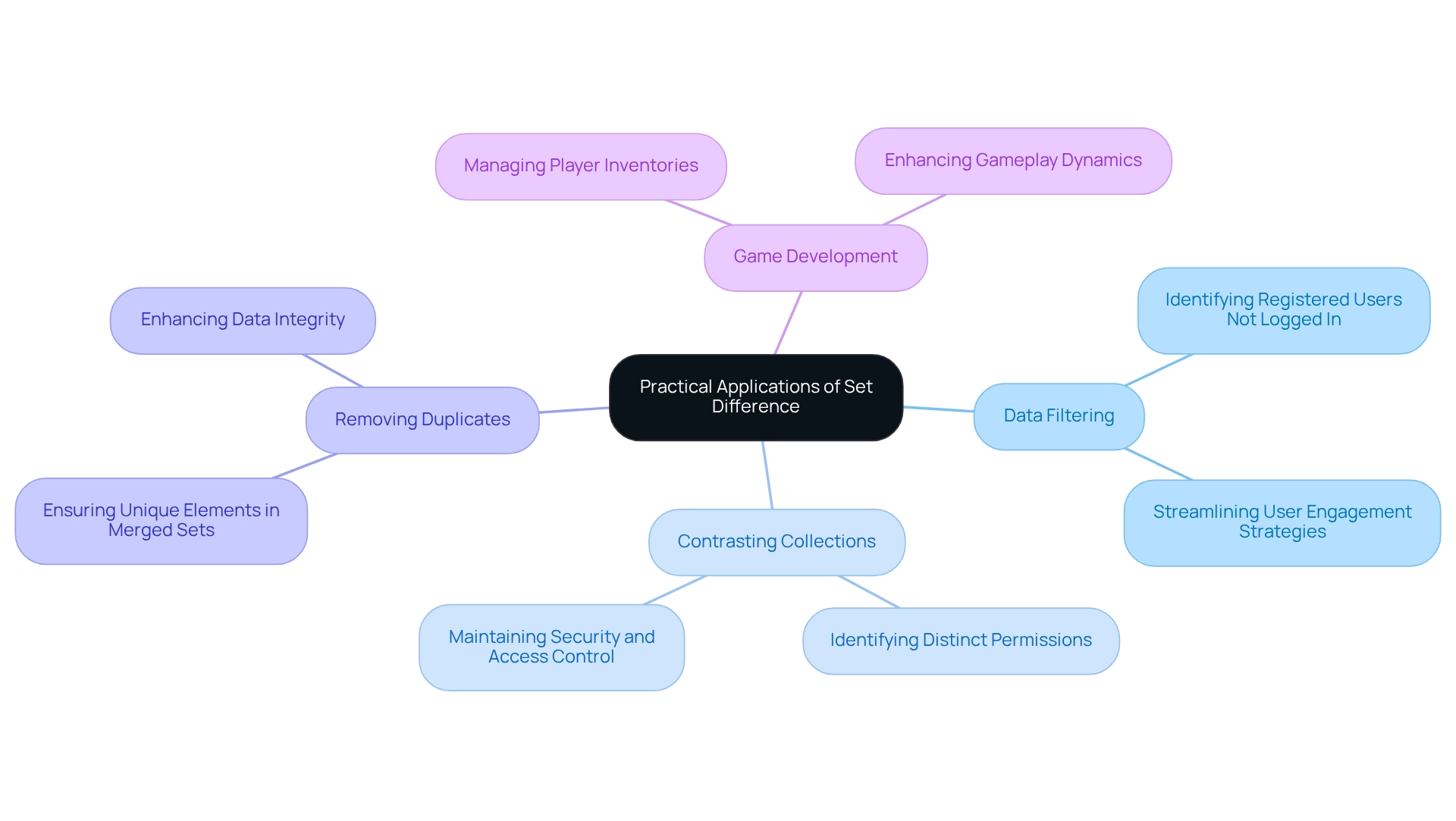Overview
The article addresses the practical applications and coding techniques associated with the set difference operation in JavaScript, a crucial method for identifying elements that exist in one set but not in another. This operation is particularly relevant for developers facing challenges in data management.
It presents various use cases, including:
- Data filtering
- Contrasting collections
- Inventory management in game development
Furthermore, the article provides code examples and discusses common challenges developers encounter, thereby underscoring the significance of mastering this operation for effective data management in programming.
Introduction
In the dynamic world of JavaScript programming, developers often face significant challenges in managing data efficiently. One powerful tool that can help navigate these challenges is the concept of set difference. This operation identifies elements unique to one set while excluding those present in another, serving not just as a mathematical curiosity but as a practical necessity in various coding scenarios. From filtering datasets to enhancing game development, understanding set difference can significantly streamline workflows and improve code clarity.
As programming continues to evolve, mastering techniques like set difference becomes essential for developers aiming to optimize their applications and maintain data integrity. This article delves into the intricacies of set difference, showcasing its implementations and practical applications. Furthermore, it addresses common pitfalls and highlights how modern tools can aid in overcoming challenges associated with this vital operation. Are you ready to explore how set difference can enhance your coding practices?
Understand Set Difference in JavaScript
In the realm of JavaScript, developers often face the challenge of managing data effectively. The set difference js operation is crucial for identifying elements that exist in one set but not in another, a process vital for tasks like data filtering and collection comparison. Mathematically represented as A - B, where A is the first set and B is the second, the set difference js operation yields a new collection featuring solely those elements exclusive to A. This functionality is indispensable for programmers handling distinct data groups, particularly when applying set difference js.
Consider the following sets:
const setA = new Set([1, 2, 3, 4]);
const setB = new Set([3, 4, 5, 6]);
When executing the set difference js (setA - setB), a new collection emerges, containing the elements 1 and 2—elements that reside in setA but are absent in setB. This operation not only streamlines data management but also enhances code clarity and efficiency.
Furthermore, the significance of set subtraction operations is underscored by recent statistics, which reveal that the result of the set of odd numbers and the set of perfect squares produces the set {3, 5, 7}. Such operations are increasingly vital in contemporary programming. Tools like Kodezi are designed to address these challenges, enabling smooth framework and language switching, which significantly boosts programmer productivity.
In addition, Kodezi's automated code troubleshooting features provide thorough explanations and insights, allowing programmers to swiftly pinpoint and resolve issues within their code. This ensures that operations such as set difference js are executed effectively and securely. As developers continue to leverage set operations, understanding their practical applications will be essential for optimizing code quality and performance. Why not explore the tools available on the Kodezi platform to enhance your coding experience?

Explore Practical Applications of Set Difference
Set variation plays a crucial role in programming, offering various practical applications that enhance efficiency and functionality. Consider the challenges developers face in managing data effectively. Set difference js emerges as a powerful tool to address these challenges across several scenarios:
- Data Filtering: In data management, set distinction is invaluable for filtering datasets. For example, if you have a list of registered users and another of users who have logged in, using set difference js can help identify those who have registered but not yet logged in. This streamlines user engagement strategies, aligning with current trends in programming where effective data filtering techniques are essential for maintaining user interaction.
- Contrasting Collections: When contrasting two collections, such as user permissions or roles, set difference js enables programmers to identify distinct permissions associated with one role compared to another. This capability is essential for maintaining security and access control in applications. Furthermore, as companies allocate 63% of their software development budgets to design and new development costs, the need for efficient programming practices becomes increasingly apparent.
- Removing Duplicates: Merging arrays or sets often leads to duplicate entries. By utilizing set difference js, developers can ensure that only unique elements are retained, thus maintaining data integrity and enhancing the quality of the final dataset. This is especially pertinent in agile settings, where 82% of teams utilize continuous integration and delivery (CI/CD) tools to guarantee quality. Techniques involving set difference js can further optimize these processes.
- Game Development: In the realm of game development, set variation can manage inventories effectively. For instance, it can identify items a player possesses that are not available in the shop. This enhances gameplay dynamics and user experience. As automation becomes more widespread in software creation, incorporating set distinction techniques can liberate programmers to concentrate on more inventive elements of their projects. This reflects ongoing discussions about the balance between automation and human creativity in AI development, and these applications not only demonstrate the adaptability of set difference js but also emphasize its significance in contemporary programming practices. By incorporating set subtraction methods, programmers can optimize their workflows, boost overall productivity, and enhance the effectiveness of CI/CD processes.
Are you ready to explore how these techniques can transform your coding practices?

Implement Set Difference with Code Examples
Coding challenges can be daunting for developers, especially when it comes to efficiently managing data structures. To tackle these challenges, Kodezi offers powerful tools that simplify complex operations like set difference in JavaScript. By leveraging the Set object, you can create a function that computes the difference between two sets seamlessly:
function setDifference(setA, setB) {
return new Set([...setA].filter(x => !setB.has(x)));
}
const setA = new Set([1, 2, 3, 4]);
const setB = new Set([3, 4, 5, 6]);
const difference = setDifference(setA, setB);
console.log(difference); // Output: Set { 1, 2 }
In addition to using the Set object, you can achieve the same result with array methods, which might be more familiar to some developers:
function arraySetDifference(arrA, arrB) {
return arrA.filter(x => !arrB.includes(x));
}
const arrayA = [1, 2, 3, 4];
const arrayB = [3, 4, 5, 6];
const differenceArray = arraySetDifference(arrayA, arrayB);
console.log(differenceArray); // Output: [1, 2]
These examples not only illustrate how to compute the set difference effectively but also highlight the flexibility of JavaScript in accommodating different coding styles. By utilizing Kodezi, developers can enhance their productivity and code quality, making their coding experience smoother and more efficient. Why not explore the tools available on the Kodezi platform to elevate your coding practices?
Troubleshoot Common Issues with Set Difference
When working with set difference js, developers often face challenges that can hinder their progress.
- Type errors are a common issue; ensuring that inputs to your set subtraction function are either sets or arrays is crucial. Passing incorrect types can lead to runtime errors, so always validate your inputs before processing to prevent these problems.
- Mutability issues also arise, as sets in JavaScript are mutable. Modifications to a set after its creation can affect your results. To avoid unintended consequences, consider creating a copy of the set before performing any operations.
- Performance concerns become significant with large datasets. Traditional array methods can lead to performance bottlenecks, so utilizing the Set object is recommended for better efficiency when handling extensive collections, as it is optimized for such operations.
- Additionally, logical errors can occur when filtering elements. Double-checking your logic is essential to ensure that your conditions accurately represent the intended set subtraction operation. Using console logs for debugging can be a powerful method to trace the data flow and identify where issues might arise.
Given that JavaScript holds a market share of 94.81%, mastering techniques like set subtraction is essential for programmers engaged in this prominent programming language. Furthermore, with 84.7% of JavaScript programmers utilizing it professionally, the significance of set difference operations in JavaScript projects cannot be overstated. By recognizing these common problems and applying the recommended solutions, you can enhance the effectiveness and efficiency of set difference js operations. This proactive approach not only improves code quality but also boosts overall productivity.
- So, how can Kodezi help? Tools like Kodezi assist developers in managing these common issues effectively, ensuring that their codebases remain robust and efficient. With Kodezi's AI-powered features, you can automatically correct code, analyze bugs, and optimize your programming efforts. This makes Kodezi an invaluable resource for enhancing your coding skills. Explore the tools available on the platform to elevate your coding experience.

Conclusion
In the face of coding challenges, understanding set difference in JavaScript is crucial for developers looking to enhance their data management and coding practices. By recognizing how this operation identifies unique elements in one set while excluding those in another, programmers can effectively streamline their workflows. The practical applications of set difference—ranging from data filtering and collection comparison to removing duplicates and managing inventories—demonstrate its versatility and significance in modern programming.
Furthermore, implementing set difference can be achieved through various methods, such as using the Set object or traditional array methods. This provides developers with the flexibility to choose the approach that best suits their coding style. However, awareness of common challenges, including type errors, mutability issues, and performance concerns, is crucial for ensuring robust and efficient code. By proactively addressing these obstacles and leveraging tools like Kodezi, developers can optimize their use of set difference operations, ultimately enhancing code quality and productivity.
As the programming landscape continues to evolve, mastering techniques like set difference will be increasingly important for developers aiming to maintain data integrity and improve application performance. Embracing these practices not only leads to cleaner, more efficient code but also positions developers to navigate the complexities of modern software development effectively. Explore the tools available on Kodezi to elevate your coding practices today.
Frequently Asked Questions
What is the set difference operation in JavaScript?
The set difference operation in JavaScript identifies elements that exist in one set but not in another, represented mathematically as A - B, where A is the first set and B is the second.
How is the set difference operation useful for developers?
It is crucial for tasks like data filtering and collection comparison, allowing programmers to manage distinct data groups effectively and enhance code clarity and efficiency.
Can you provide an example of the set difference operation?
Yes, for example, if setA is defined as new Set([1, 2, 3, 4]) and setB as new Set([3, 4, 5, 6]), executing the set difference operation (setA - setB) results in a new collection containing the elements 1 and 2, which are exclusive to setA.
What are the benefits of using tools like Kodezi in relation to set operations?
Tools like Kodezi facilitate smooth framework and language switching, boost programmer productivity, and provide automated code troubleshooting features that help programmers quickly identify and resolve issues in their code.
Why are set subtraction operations important in contemporary programming?
They are increasingly vital for optimizing code quality and performance, as they allow developers to efficiently manage and manipulate data sets in their applications.




